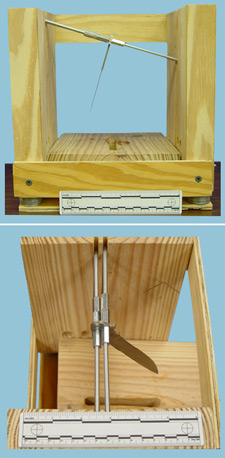Home | Glossary | Resources | Help | Contact Us | Course Map
Archival Notice
This is an archive page that is no longer being updated. It may contain outdated information and links may no longer function as originally intended.
Production of Test Toolmarks
To maximize effectiveness and efficiency when producing test marks as a basis for comparison against a toolmark made by an evidence tool, a number of variables must be considered:
- The manner in which the tool acted on a toolmarked surface (the action employed).
- The area(s) of the tools operating surface that was used.
- The amount of force used on the tool
- The direction in which the operating surface of the tool moved. With some tools this may be very limited (bolt cutters); with other tools there may be nearly unlimited directions (a screwdriver).
- The angle or orientation of the tool relative to the marked surface.
- The physical circumstances of the crime scene that may limit how a tool could be used (e.g., a wall adjacent to a door lock that forces a tool of a given size to be used in a particular orientation).
The type of surface in which an evidence toolmark is found determines the test medium used to reproduce the mark. It is important not to alter the tool when obtaining a test mark; a softer medium, such as simple sheet lead, should be used.
Typically, it is necessary to perform a number of tests to obtain a result that most closely resembles the evidence mark. Test marks should be microscopically intercompared to ensure the reproducibility of marks. Whether dealing with striated marks or impressions, tools with a limited operating surface and few options as to their orientation with the surface they mark are the easiest tools from which to obtain test marks.
When obtaining test marks, it is important to relate the cut edges or impressions to the corresponding operating surface of the tool by color coding, numbering, or lettering. This systematic approach allows for detailed documentation and imaging.
Many examiners find it useful to use personally designed devices as a convenience in reproducing toolmarks of various types. Because there are no suppliers of specialized equipment for replicating toolmarks, the examiner must be prepared to adapt and improvise.
Additional Online Courses
- What Every First Responding Officer Should Know About DNA Evidence
- Collecting DNA Evidence at Property Crime Scenes
- DNA – A Prosecutor’s Practice Notebook
- Crime Scene and DNA Basics
- Laboratory Safety Programs
- DNA Amplification
- Population Genetics and Statistics
- Non-STR DNA Markers: SNPs, Y-STRs, LCN and mtDNA
- Firearms Examiner Training
- Forensic DNA Education for Law Enforcement Decisionmakers
- What Every Investigator and Evidence Technician Should Know About DNA Evidence
- Principles of Forensic DNA for Officers of the Court
- Law 101: Legal Guide for the Forensic Expert
- Laboratory Orientation and Testing of Body Fluids and Tissues
- DNA Extraction and Quantitation
- STR Data Analysis and Interpretation
- Communication Skills, Report Writing, and Courtroom Testimony
- Español for Law Enforcement
- Amplified DNA Product Separation for Forensic Analysts


